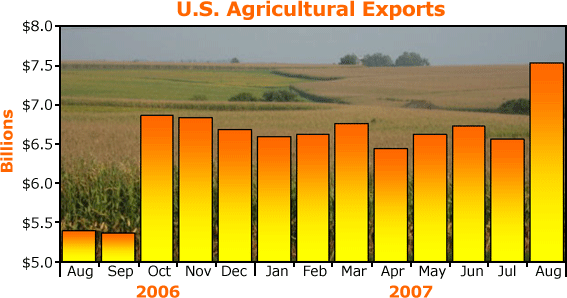USDA Drops an Agricultural Bombshell!
Commodities / Agricultural Commodities Oct 18, 2007 - 04:10 AM GMT

 Sean Brodrick writes: The USDA dropped a bombshell last week — reporting that U.S. wheat stockpiles may fall to the lowest level in 59 years! As disturbing as that is, it is 100% bullish for grain prices, especially given soaring worldwide demand for agricultural products.
Sean Brodrick writes: The USDA dropped a bombshell last week — reporting that U.S. wheat stockpiles may fall to the lowest level in 59 years! As disturbing as that is, it is 100% bullish for grain prices, especially given soaring worldwide demand for agricultural products.
Global stockpiles have already fallen to 26-year lows. World stocks of grain — that is, the food held in reserve for times of emergency — are now sufficient for just over 50 days. This is already lighting a fire under prices on your grocer's shelves. But if you think you've seen high prices, just wait … you ain't seen nothin' yet.
Our wheat stockpiles are being whittled away because of a combination of rapidly rising demand in emerging markets and terrible harvests that have been compounded by the effects of global warming.
What really shocks me — and should scare you — is that stockpiles are dwindling even as yields are growing enormously!
In World War II, American farmers harvested about 17 bushels of wheat per acre …
By 1972, that nearly doubled to 33.9 bushels per acre …
And this year, it should come in at 40.6 bushels per acre!
So even though the number of acres devoted to wheat is down a third (28 million acres) from their peak in 1981, we should be growing plenty of wheat.
Corn yields are rising even more dramatically:
In World War II, the corn yield was 39 bushels per acre …
 |
| We should be swimming in corn, but that's not the case! |
By 1970, it was 72.4 bushels per acre …
This year, the USDA expects 155.8 bushels per harvested acre, and a bumper crop overall.
So we're growing just as much acreage now as we did in World War II! Why aren't we drowning in corn?
- More and more corn is being siphoned off to make ethanol. About 20% of last year's U.S. corn crop went to make ethanol. Plus, annual corn-based ethanol output in the U.S. is expected to double between 2006 and 2016.
- It's not just ethanol, either. The USDA says total corn usage will jump 5.3% to 763.7 million tons.
- With prices for other feed supplies rising, farmers are using more corn for their animals.
- Plus, a series of bad harvests around the world is making U.S. corn a hot commodity.
Let me expand on that last point. A bad wheat harvest in the Ukraine, normally one of Europe's breadbaskets, was followed by poor harvests in Russia, Egypt, and Australia.
The USDA projects wheat supplies for the 2007-2008 crop year will fall to 307 million bushels, down 55 million bushels from its estimate last month, due to the fast pace of export shipments.
Globally, the USDA expects wheat production to come in at 600.5 million tons, down from 606.2 million last month.
And the USDA just slashed its estimates of Australia's harvest — again! — to 13.5 million tons from 21 million.
Meanwhile, Asian Nations Continue to Demand More and More Food …
 |
| Chinese consumers have more money to buy up food than ever before … |
China, once a huge exporter of corn, is now becoming a corn importer for the first time in a decade. The country's exports will plunge to 1.5 million tons from 5.2 million this year!
China's domestic grain supply fell short by 10 million tons last year, and despite bumper crops, the problem should get worse going forward.
The country's soybean imports are up 2.1% year over year in September, and it will import almost 50% of the world's oilseeds within a decade, becoming the world's largest importer, according to estimates from the Organization for Economic Cooperation and Development.
Want core facts on China that are bullish for grain prices? Along with its plunging corn production …
- An outbreak of disease led to the death of thousands of pigs in China, pushing meat prices 49% higher in August.
- Drought has withered 27 million acres in the northern and western sections of the country.
- Floods have drowned 21.5 million acres in southern China.
- A plague of brown rice-plant hoppers have damaged 1.2 million acres in Sichuan Province.
- Between 2000 and 2005, China lost over three million acres of farmland each year to industrialization and other factors!
The farmland situation is so bad that China is investing nearly $4 billion to help develop 2.4 million acres in the Philippines. The land will be used to grow corn, rice, and sorghum. The deal isn't legal under the Philippines constitution, but money talks.
And as rip-roaring as the demand from China is, there is another hungry and growing nation of consumers that could eclipse it …
India's middle class is larger than the population of the United States, but more than 300 million people in India still live on less than the equivalent of $1 a day. That may be changing, though, thanks to India's rip-roaring economic growth.
Important: Despite its rising GDP, India's production of food grains has remained stagnant for a decade!
 |
| India's production of food grains has remained stagnant for a decade! |
Adding to the pressure on farmland is the fact that India, which has very little petroleum of its own, is becoming very interested in biofuels. The Indian government says it wants to plant 35 million acres of biofuel crops. That's land that won't be used to grow food, and so more food will have to be imported.
Also, as people in India and China get richer, they want to eat more meat. That's 40% of the world's people giving up their traditional vegetable-rich diets to adopt typical "American" diets that contain more meat and dairy products. This puts much more pressure on grain supplies, because it takes seven pounds of grain to produce one pound of beef.
Bottom line: Meat demand in China has quadrupled in 30 years, and in India, milk and egg products are becoming increasingly popular.
It's the same story all over Asia — countries are lining up for grains. Heck, U.S. exporters just reported sales of 242,000 metric tonnes of corn to South Korea.
All This Demand on America's Farms Is Hitting Consumers Right in their Breadbaskets!
The price of food and beverages rose 4.2% in the 12 months ended August, led by a 12% jump in dairy items, according to the consumer price index. Nationwide, milk prices are up 18% since the start of the year, while eggs cost 35% more than they did a year ago.
Some wholesalers have tried to disguise the pain for consumers. In June, General Mills shrunk its cereal package sizes while keeping prices the same. Others are simply passing the pain along. Kellogg boosted prices 5% in April based on weight, and Starbucks is charging more for lattes and other drinks to cover its milk costs.
Food is really a sellers' market — you can decide to do without a lot of things, but you need food.
The USDA estimates overall food price inflation will run 3% to 4% in 2008. I think they should wake up and smell the coffee — it wouldn't surprise me to see food inflation DOUBLE the USDA's estimates!
How high can prices go? Today, about 8.5% of the American household budget goes to food at home. That's way down from an average of 19% of the total budget in 1960.
Historically, food takes up a much larger part of our budget — people in developing countries devote up to a THIRD of their budgets to food. And one of the truths of investing is that commodities usually revert to the historical mean.
The U.S. dollar's decline has only made things more complicated. Cheaper greenbacks make U.S. agricultural products — wheat, soybeans, corn — more affordable for foreigners. Just look at this chart I made with data from the USDA …

You can see that in August, U.S. agricultural exports jumped to $7.5 billion — nearly 40% over the year-earlier period.
I've already told you how badly China and India need our grains. Well, Egypt also imports 50% of its wheat … and Japan imports 99%!
Countries are lining up to buy U.S.-grown grain they consider "cheap." And that could really kick food inflation into overdrive.
This problem is only going to get worse over time. Even as desertification brought on by global warming takes its toll, the global population is rising by 87 million people a year. There will be more people … and they'll want to eat more grain … and more of that will be imported from the U.S.
About 15% of the world's present food supply, on which 160 million people depend, is being grown with water drawn from rapidly depleting underground sources or from rivers that are drying up.
What else are all these new mouths going to eat? Fish? Sorry, but recent reports in Science and Nature suggest that one-third of ocean fisheries are in collapse, two-thirds will be in collapse by 2025, and all major ocean fisheries may be virtually gone forty years from now!
Times of Peril Yield Potential for Profit
I'm not happy about this sad state of affairs. But you have only two options — sit idly by and do nothing … or start positioning your portfolio to ride the wave of rising agriculture prices. At least the latter strategy will help you keep putting food on the table!
If you want a piece of the red-hot market in agriculture, you might consider investing in the Fidelity Select Consumer Staples Portfolio (FDFAX). Formerly known as Fidelity Select Food & Agriculture, it covers the gamut of food stocks, including some great agriculture-oriented stocks.
Or, for the really big potential returns in agriculture, I've picked out six individual stocks and one red-hot ETF. I put those picks in a report which was published last month. It's called " 6 Stocks and 1 ETF to Ride the Agriculture Boom ," and covers every step of the agricultural process — fertilizer companies, a seed company, farm equipment and more!
| Agriculture Boom All positions added end of day 09/13/2007 |
||
| Name | Open Gain or Loss | Percent Change |
| Stock #1 | $292.00 | 17.10% |
| Stock #2 | $2,086.00 | 23.55% |
| Stock #3 | $1,898.00 | 26.23% |
| Stock #4 | $1,932.00 | 21.76% |
| Stock #5 | $154.00 | 2.32% |
| Stock #6 | $629.00 | 6.47% |
| Fund | $690.00 | 16.47% |
| TOTAL: | $7,681.00 | 16.26% |
And wouldn't you know it — subscribers are already racking up hefty open gains! Take a look at my snapshot of how the positions have been doing.
Is it too late? No way! For all the reasons I just explained, this agriculture boom has a long way to go. And I think the best stocks and funds have just begun to lift off.
Yours for trading profits,
Sean
P.S. If you're interested in ordering my report today, you can buy it right now — and get it e-mailed to you today — for $198. What's more, I'm throwing in three follow-ups to tell you when to sell and perhaps when to buy more. Call 1-800-291-8545 or order online. Just click here for more details.
This investment news is brought to you by Money and Markets . Money and Markets is a free daily investment newsletter from Martin D. Weiss and Weiss Research analysts offering the latest investing news and financial insights for the stock market, including tips and advice on investing in gold, energy and oil. Dr. Weiss is a leader in the fields of investing, interest rates, financial safety and economic forecasting. To view archives or subscribe, visit http://www.moneyandmarkets.com .
Money and Markets Archive |
© 2005-2022 http://www.MarketOracle.co.uk - The Market Oracle is a FREE Daily Financial Markets Analysis & Forecasting online publication.


